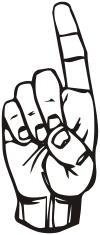Definify.com
Webster 1913 Edition
D
D
Definition 2025
D
D
 | ||||||
| ||||||
|---|---|---|---|---|---|---|
Translingual
Etymology 1
 From Etruscan 𐌃 (D), from Greek Δ (D, “Delta”), from Phoenician 𐤃 (D, “dalet”).
From Etruscan 𐌃 (D), from Greek Δ (D, “Delta”), from Phoenician 𐤃 (D, “dalet”).
Letter
D upper case (lower case d)
- The fourth letter of the basic modern Latin alphabet.
See also
- (Latin script): Aa Bb Cc Dd Ee Ff Gg Hh Ii Jj Kk Ll Mm Nn Oo Pp Qq Rr Sſs Tt Uu Vv Ww Xx Yy Zz
- (Variations of letter D): Ďď Ḋḋ Ḑḑ Ḍḍ Ḓḓ Ḏḏ Đđ D̦d̦ Ɖɖ Ɗɗ Ƌƌ ᵭ ᶁ ᶑ ȡ ᴅ Dd ȸ DZDzdz DZDzdz DŽDždž DŽDždž
Etymology 2
A simplification of Ð under the graphic influence of the letter D, from a standardization of Ɔ superposed on a ⋌ or ⊢, from the practice of circling each hundredth ⋌ (now Roman numeral V), the tally stick notch mark representing five.
Numeral
D (upper case Roman numeral, lower case d)
- (mathematics) cardinal number five hundred (500).
Etymology 3
- (chemistry, deuterium): abbreviation of deuterium
- (computing, hexadecimal 13): From its position as the thirteenth element of the series {1, 2, 3, 4, 5, 6, 7, 8, 9, A, B, C, D, E, F}
- (Germany): abbreviation of German word Deutschland (“Germany”)
Symbol
D
- (chemistry) Deuterium, when it needs to be distinguished from ordinary hydrogen.
- (computing) Hexadecimal symbol for thirteen.
- A standard size of dry cell battery larger than C.
- Vehicle-distinguishing sign for Germany.
- (biochemistry) IUPAC one-letter abbreviation for aspartic acid.
- (mathematics) The differential operator in calculus and analysis.
See also
Other representations of D:
|
- Letter styles
-

Capital and lowercase versions of D, in normal and italic type
-

Uppercase and lowercase D in Fraktur
English
Pronunciation
- Letter name: IPA(key): /diː/
- Rhymes: -iː
- Phoneme: IPA(key): /d/
Letter
D (upper case, lower case d, plural Ds or D's)
- The fourth letter of the English alphabet, called dee and written in the Latin script.
- 1945 May, George Orwell, chapter 3, in Animal Farm: A Fairy Story, London: Secker & Warburg, OCLC 3655473:
- Boxer could not get beyond the letter D. He would trace out A, B, C, D, in the dust with his great hoof […]
-
See also
- (Latin script letters) letter; Aa, Bb, Cc, Dd, Ee, Ff, Gg, Hh, Ii, Jj, Kk, Ll, Mm, Nn, Oo, Pp, Qq, Rr, Ss, Tt, Uu, Vv, Ww, Xx, Yy, Zz
Number
D (upper case, lower case d)
- The ordinal number fourth, derived from this letter of the English alphabet, called dee and written in the Latin script.
Etymology 2
Various abbreviations
Abbreviation
D
- Defense.
- (US, politics) Democrat, especially preceding the constituent location.
- D-New York
- Divorced.
- Down (direction).
- Drive, the setting of an automatic transmission.
- (printing) Duodecimo, as adopted by the American Library Association.
- Dutch language.
- (with “The”) The City of Detroit.
- (euphemistic) Dick; ****.
- She wants the D!
- (electronics) Data.
- (Unicode) Canonical Decomposition
- (euphemistic) Damn
- 1878, W. S. Gilbert and Arthur Sullivan, "I am the Captain of the Pinafore", H.M.S. Pinafore
- CAPTAIN. I never use a big, big D— ALL. What, never? CAPTAIN. No, never! ALL. What, never? CAPTAIN. Hardly ever! ALL. Hardly ever swears a big, big D—
- 1878, W. S. Gilbert and Arthur Sullivan, "I am the Captain of the Pinafore", H.M.S. Pinafore
See also
Derived terms
References
- Unicode Consortium, Unicode Standard Annex #15, revision 41 (2014-06-05), § 1.2, table 1: “Normalization Forms”
Etymology 3
From the shape of the upper case letter "D"
Noun
D (plural Ds)
- (snooker) The semicircle on the baulk line, inside which the cue ball must be placed at a break-off.
Etymology 4
From the position (4) of the letter D in the English alphabet.
Noun
D (plural Ds)
- a grade awarded for a class, better than outright failure (which can be F or E depending on the institution) and worse than a C
Proper noun
D
- (computer languages) A programming language inspired from C++.
Azeri
Letter
D upper case (lower case d)
See also
- (Latin script letters) hərf; Aa, Bb, Cc, Çç, Dd, Ee, Əə, Ff, Gg, Ğğ, Hh, Xx, Iı, İi, Jj, Kk, Qq, Ll, Mm, Nn, Oo, Öö, Pp, Rr, Ss, Şş, Tt, Uu, Üü, Vv, Yy, Zz
Chinese
Pronunciation
- Cantonese
- (Standard Cantonese, Guangzhou)+
- Jyutping: di1
- Yale: dī
- Cantonese Pinyin: di1
- IPA (key): /tiː⁵⁵/
- (Standard Cantonese, Guangzhou)+
Noun
D
Suffix
D
Dutch
Pronunciation
- (letter name): IPA(key): /deː/
Letter
D (upper case, lower case d)
See also
- (Latin script letters) letter; Aa, Bb, Cc, Dd, Ee, Ff, Gg, Hh, Ii, Jj, Kk, Ll, Mm, Nn, Oo, Pp, Qq, Rr, Ss, Tt, Uu, Vv, Ww, Xx, Yy, Zz
Esperanto
Pronunciation
- (letter name): IPA(key): /do/
- (phoneme): IPA(key): /d/
Letter
D (upper case, lower case d)
See also
- (Latin script letters) litero; Aa, Bb, Cc, Ĉĉ, Dd, Ee, Ff, Gg, Ĝĝ, Hh, Ĥĥ, Ii, Jj, Ĵĵ, Kk, Ll, Mm, Nn, Oo, Pp, Rr, Ss, Ŝŝ, Tt, Uu, Ŭŭ, Vv, Zz
Finnish
Letter
D (upper case, lower case d)
Usage notes
- Used only in loanwords except for the weak grade of t.
See also
- (Latin script letters) letter; Aa, Bb, Cc, Dd, Ee, Ff, Gg, Hh, Ii, Jj, Kk, Ll, Mm, Nn, Oo, Pp, Qq, Rr, Ss, Šš, Tt, Uu, Vv, Ww, Xx, Yy, Zz, Žž, Åå, Ää, Öö
German Sign Language
Etymology
Related to the French Sign Language sign for "D".
Production
This one-handed GSL sign is produced as follows:
- Posture the dominant hand in the “D” shape.
Letter

- the letter D
Hungarian
Pronunciation
- IPA(key): [ˈdeːl]
Noun
D (plural D-ek)
Declension
The declined forms below are used only in writing. When speaking, the declined forms of the full word should be used, as shown at dél.
| Inflection (stem in -e-, front unrounded harmony) | ||
|---|---|---|
| singular | plural | |
| nominative | D | D-ek |
| accusative | D-et | D-eket |
| dative | D-nek | D-eknek |
| instrumental | D-lel | D-ekkel |
| causal-final | D-ért | D-ekért |
| translative | D-lé | D-ekké |
| terminative | D-ig | D-ekig |
| essive-formal | D-ként | D-ekként |
| essive-modal | — | — |
| inessive | D-ben | D-ekben |
| superessive | D-en | D-eken |
| adessive | D-nél | D-eknél |
| illative | D-be | D-ekbe |
| sublative | D-re | D-ekre |
| allative | D-hez | D-ekhez |
| elative | D-ből | D-ekből |
| delative | D-ről | D-ekről |
| ablative | D-től | D-ektől |
| Possessive forms of D | ||
|---|---|---|
| possessor | single possession | multiple possessions |
| 1st person sing. | D-em | D-eim |
| 2nd person sing. | D-ed | D-eid |
| 3rd person sing. | D-e | D-ei |
| 1st person plural | D-ünk | D-eink |
| 2nd person plural | D-etek | D-eitek |
| 3rd person plural | D-ük | D-eik |
See also
Ido
Pronunciation
- IPA(key): /d/
Letter
D (lower case d)
See also
- (Latin script letters) litero; Aa, Bb, Cc, Dd, Ee, Ff, Gg, Hh, Ii, Jj, Kk, Ll, Mm, Nn, Oo, Pp, Qq, Rr, Ss, Tt, Uu, Vv, Ww, Xx, Yy, Zz
Italian
Pronunciation
Letter
D m, f (invariable, lower case d)
See also
- (Latin script letters) lettera; Aa, Bb, Cc, Dd, Ee, Ff, Gg, Hh, Ii, (Jj), (Kk), Ll, Mm, Nn, Oo, Pp, Qq, Rr, Ss, Tt, Uu, Vv, (Ww), (Xx), (Yy), Zz
-
 Italian alphabet on Wikipedia.Wikipedia
Italian alphabet on Wikipedia.Wikipedia
Latvian
Etymology
Proposed in 1908 as part of the new Latvian spelling by the scientific commission headed by K. Mīlenbahs, which was accepted and began to be taught in schools in 1909. Prior to that, Latvian had been written in German Fraktur, and sporadically in Cyrillic.
Pronunciation
- IPA(key): [d]
Letter

D (upper case, lower case d)
See also
- Letters of the Latvian alphabet:
Malay
Pronunciation
- (Name of letter) IPA(key): [di]
- (Phoneme, Syllable initial) IPA(key): [d]
- (Phoneme, Syllable final) IPA(key): [t̚]
Letter
D
See also
- (Latin script letters) Aa, Bb, Cc, Dd, Ee, Ff, Gg, Hh, Ii, Jj, Kk, Ll, Mm, Nn, Oo, Pp, Qq, Rr, Ss, Tt, Uu, Vv, Ww, Xx, Yy, Zz
Portuguese
Letter
D (upper case, lower case d)
See also
- (Latin script letters) letra; Aa, Bb, Cc, Dd, Ee, Ff, Gg, Hh, Ii, Jj, Kk, Ll, Mm, Nn, Oo, Pp, Qq, Rr, Ss, Tt, Uu, Vv, Ww, Xx, Yy, Zz
Noun
D m
- Abbreviation of dom. (as a title)
Romanian
Pronunciation
- IPA(key): /de/
Letter
D (upper case, lower case d)
See also
- (Latin script letters) Aa, Ăă, Ââ, Bb, Cc, Dd, Ee, Ff, Gg, Hh, Ii, Îî, Jj, Kk, Ll, Mm, Nn, Oo, Pp, Qq, Rr, Ss, Șș, Tt, Țț, Uu, Vv, Ww, Xx, Yy, Zz
Saanich
Pronunciation
- IPA(key): /tʼ/
Letter
D
See also
- (Latin script letters) A, Á, Ⱥ, B, C, Ć, Ȼ, D, E, H, I, Í, J, K, Ꝁ/K̵/₭, Ḵ, Ḱ, L, Ƚ, M, N, Ṉ, O, P, Q, S, Ś, T, Ⱦ, Ṯ, Ŧ, U, W, W̲, X, X̲, Y, Z, s
Skolt Sami
Pronunciation
- (phoneme) IPA(key): /d/
Letter
D (lower case d)
See also
- (Latin script letters) bukva; Aa, Ââ, Bb, Cc, Čč, Ʒʒ, Ǯǯ, Dd, Đđ, Ee, Ff, Gg, Ǧǧ, Ǥǥ, Hh, Ii, Jj, Kk, Ǩǩ, Ll, Mm, Nn, Ŋŋ, Oo, Õõ, Pp, Rr, Ss, Šš, Tt, Uu, Vv, Zz, Žž, Åå, Ää, ˊ
Slovene
Letter
D (upper case, lower case d)
See also
- (Latin script letters) Aa, Bb, Cc, Čč, Dd, Ee, Ff, Gg, Hh, Ii, Jj, Kk, Ll, Mm, Nn, Oo, Pp, Rr, Ss, Šš, Tt, Uu, Vv, Zz, Žž
Somali
Pronunciation
Letter
D upper case (lower case d)
Usage notes
- The seventh letter of the Somali alphabet, which follows Arabic abjad order. It is preceded by KH and followed by R.
See also
- (Latin script letters) ', Bb, Tt, Jj, Xx, Khkh, Dd, Rr, Ss, Shsh, Dhdh, Cc, Gg, Ff, Qq, Kk, Ll, Mm, Nn, Ww, Hh, Yy, Aa, Ee, Ii, Oo, Uu
Turkish
Letter
D (upper case, lower case d)
See also
- (Latin script letters) harf; Aa, Bb, Cc, Çç, Dd, Ee, Ff, Gg, Ğğ, Hh, Iı, İi, Jj, Kk, Ll, Mm, Nn, Oo, Öö, Pp, Rr, Ss, Şş, Tt, Uu, Üü, Vv, Yy, Zz
Vietnamese
Pronunciation
- (Hà Nội) IPA(key): [z̻e˧˧/, /ˀɗe˧˧/, /z̻əːɰ˨˩]
- (Huế) IPA(key): [jej˧˧/, /ˀɗej˧˧/, /jəːɰ˧˧]
- (Hồ Chí Minh City) IPA(key): [jej˧˥/, /ˀɗej˧˥/, /jəːɰ˨˩]
- Phonetic: dê, đê, dờ
Letter
D (upper case, lower case d)
See also
d
d
 | ||||||
| ||||||
|---|---|---|---|---|---|---|
Translingual
Etymology 1
![]() Modification of capital letter D, from Ancient Greek letter Δ (D, “Delta”).
Modification of capital letter D, from Ancient Greek letter Δ (D, “Delta”).
Letter
d lower case (upper case D)
- The fourth letter of the basic modern Latin alphabet.
Usage notes
The letter d is used in the alphabets of many languages, and in several romanization systems of non-Latin scripts to represent the voiced alveolar plosive (/d/). In some languages and transcription systems where unaspirated stops contrast with aspirated stops, d represents an unaspirated /t/, while t represents an aspirated /tʰ/.
See also
- (Latin script): Aa Bb Cc Dd Ee Ff Gg Hh Ii Jj Kk Ll Mm Nn Oo Pp Qq Rr Sſs Tt Uu Vv Ww Xx Yy Zz
- (Variations of letter D): Ďď Ḋḋ Ḑḑ Ḍḍ Ḓḓ Ḏḏ Đđ D̦d̦ Ɖɖ Ɗɗ Ƌƌ ᵭ ᶁ ᶑ ȡ ᴅ Dd ȸ DZDzdz DZDzdz DŽDždž DŽDždž
- (select similar letters and symbols) ∂ ₫ ð
- (other scripts) δ (d), д (d), ד, د (d)
- See Appendix:Variations of "d"
Etymology 2
Lower case form of upper case roman numeral D, a standardization of D or Ð, from tally stick markings resembling a superimposed Ɔ and ⋌, from the practice of encircling each hundredth ⋌ notch.
Alternative forms
Numeral
d (lower case Roman numeral, uper case D)
- cardinal number five hundred (500).
Usage notes
With a bar over the numeral, i.e., as d, it represents five hundred thousand (500,000).
See also
- Lesser roman numeral symbol: c (“100”)
- Greater roman numeral symbol: m (“1000”)
- Roman numerals
Etymology 3
Pronunciation
Symbol
d
- (mathematics) the (path-independent, exact) differential of a quantity
- (IPA) voiced alveolar plosive
See also
- (mathematics): δ
Other representations of D:
|
- Letter styles
-

Capital and lowercase versions of D, in normal and italic type
-

Uppercase and lowercase D in Fraktur
-

Approximate form of upper case letter D in uncial script that was the source for lower case d
English
Pronunciation
- (letter name): IPA(key): /ɖiː/
- (phoneme): IPA(key): /ɖ/
- (phoneme): IPA(key): /ɖ/
Letter
d (lower case, upper case D, plural d's)
See also
- (Latin script letters) letter; Aa, Bb, Cc, Dd, Ee, Ff, Gg, Hh, Ii, Jj, Kk, Ll, Mm, Nn, Oo, Pp, Qq, Rr, Ss, Tt, Uu, Vv, Ww, Xx, Yy, Zz
Derived terms
Number
d (lower case, upper case D)
- The ordinal number fourth, derived from this letter of the English alphabet, called dee and written in the Latin script.
Etymology 2
- (died, death): abbreviation of
- (British penny; old penny): abbreviation of Latin denarii, the name of the corresponding Roman coin.
- (dice): abbreviation of dice
Abbreviation
d
Symbol
d
- (until February 1971) a British penny; an old penny (the modern decimal penny being abbreviated p).
- £sd — “pounds, shillings and pence”
- (dice games, infix) dice to use in a diceroll
- 2d6 — “the sum of the roll of two six-sided dice”
- penny, a measure of the size of nails
Alemannic German
Article
d f
- (definite) the
- 1978, Rolf Lyssey and Christa Maerker, Die Schweizermacher (transcript):
- Di nöchscht rächts. Mir fared i d’Fäldschtrass.
- The next right. We'll drive down Feldstrasse.
- Di nöchscht rächts. Mir fared i d’Fäldschtrass.
- 1978, Rolf Lyssey and Christa Maerker, Die Schweizermacher (transcript):
d pl
- (definite) the
Declension
| Alemannic German definite articles | ||||
|---|---|---|---|---|
| Masculine | Feminine | Neuter | Plural | |
| Nominative/Accusative | de dr (Bern) |
d | s ds (Bern) |
d |
| Dative | em | der | em | de |
- Masculine nominative/accusative singular de has the form der before a vowel, e.g. der alt Maa ‘the old man’
- Dative plural de has the form den before a vowel, e.g. den alte Fraue ‘(to) the old women’
- Feminine singular d and plural d have the variant di before an adjective, e.g. di jung Mueter ‘the young mother’
Azeri
Letter
d lower case (upper case D)
See also
- (Latin script letters) hərf; Aa, Bb, Cc, Çç, Dd, Ee, Əə, Ff, Gg, Ğğ, Hh, Xx, Iı, İi, Jj, Kk, Qq, Ll, Mm, Nn, Oo, Öö, Pp, Rr, Ss, Şş, Tt, Uu, Üü, Vv, Yy, Zz
Chinese
Pronunciation
- Cantonese
- (Standard Cantonese, Guangzhou)+
- Jyutping: di1
- Yale: dī
- Cantonese Pinyin: di1
- IPA (key): /tiː⁵⁵/
- (Standard Cantonese, Guangzhou)+
Noun
d
Suffix
d
Dutch
Pronunciation
- Rhymes: -eː
- (letter name): IPA(key): /deː/
Letter
d (lower case, upper case D)
See also
Esperanto
Pronunciation
Letter
d (lower case, upper case D)
See also
- (Latin script letters) litero; Aa, Bb, Cc, Ĉĉ, Dd, Ee, Ff, Gg, Ĝĝ, Hh, Ĥĥ, Ii, Jj, Ĵĵ, Kk, Ll, Mm, Nn, Oo, Pp, Rr, Ss, Ŝŝ, Tt, Uu, Ŭŭ, Vv, Zz
Faroese
Pronunciation
- IPA(key): /t/
Letter
d (upper case D)
See also
- (Latin script letters) bókstavur; Aa, Áá, Bb, Dd, Ðð, Ee, Ff, Gg, Hh, Ii, Íí, Jj, Kk, Ll, Mm, Nn, Oo, Óó, Pp, Rr, Ss, Tt, Uu, Úú, Vv, Yy, Ýý, Ææ, Øø
Fijian
Pronunciation
- (phoneme) IPA(key): /nd/
Letter
d (lower case, upper case D)
See also
- (Latin script letters) Aa, Bb, Cc, Dd, Ee, Ff, Gg, Ii, Jj, Kk, Ll, Mm, Nn, Oo, Pp, Qq, Rr, Ss, Tt, Uu, Vv, Ww, Yy
French
Letter
d (lower case, upper case D)
- The fourth letter of the French alphabet, written in the Latin script.
- 1837, Louis Viardot, L’Ingénieux Hidalgo Don Quichotte de la Manchefr.Wikisource, translation of El ingenioso hidalgo Don Quijote de la Mancha by Miguel de Cervantes Saavedra, Volume I, Chapter II:
- [À] peine les petits oiseaux nuancés de mille couleurs avaient-ils salué des harpes de leurs langues, dans une douce et mielleuse harmonie, la venue de l’aurore au teint de rose, ... que le fameux chevalier don Quichotte de la Manche ... prit sa route à travers l’antique et célèbre plaine de Montiel.
- [S]carce had the little birds shaded of a thousand colours hailed from the harps of their tongues, in a soft and mellifluous harmony, the coming of the pink-tinted dawn, ... when the famous knight Don Quixote of La Mancha ... took his route across the ancient and famous Campo de Montiel.
-
Ido
Pronunciation
- IPA(key): /d/
Letter
d (upper case D)
See also
- (Latin script letters) litero; Aa, Bb, Cc, Dd, Ee, Ff, Gg, Hh, Ii, Jj, Kk, Ll, Mm, Nn, Oo, Pp, Qq, Rr, Ss, Tt, Uu, Vv, Ww, Xx, Yy, Zz
Latvian
Etymology
Proposed in 1908 as part of the new Latvian spelling by the scientific commission headed by K. Mīlenbahs, which was accepted and began to be taught in schools in 1909. Prior to that, Latvian had been written in German Fraktur, and sporadically in Cyrillic.
Pronunciation
- IPA(key): [d]
Letter

d (lower case, upper case D)
See also
- Letters of the Latvian alphabet:
Livonian
Pronunciation
- (phoneme) IPA(key): /d̪/
Letter
d (upper case D)
See also
- (Latin script letters) kēratēḑ; Aa, Āā, Ää, Ǟǟ, Bb, Dd, Ḑḑ, Ee, Ēē, Ff, Gg, Hh, Ii, Īī, Jj, Kk, Ll, Ļļ, Mm, Nn, Ņņ, Oo, Ōō, Ȯȯ, Ȱȱ, Õõ, Ȭȭ, Pp, Rr, Ŗŗ, Ss, Šš, Tt, Țț, Uu, Ūū, Vv, Zz, Žž,
Malay
Letter
d (lower case, upper case D)
See also
- (Latin script letters) Aa, Bb, Cc, Dd, Ee, Ff, Gg, Hh, Ii, Jj, Kk, Ll, Mm, Nn, Oo, Pp, Qq, Rr, Ss, Tt, Uu, Vv, Ww, Xx, Yy, Zz
Norwegian
Pronunciation
- (letter name): IPA(key): /deː/
- (phoneme): IPA(key): /d/, /ɖ/*
- Homophone: det
Letter
d
Usage notes
- Retroflex, merge of rd.
Portuguese
Pronunciation
Letter
d (lower case, upper case D)
See also
- (Latin script letters) letra; Aa, Bb, Cc, Dd, Ee, Ff, Gg, Hh, Ii, Jj, Kk, Ll, Mm, Nn, Oo, Pp, Qq, Rr, Ss, Tt, Uu, Vv, Ww, Xx, Yy, Zz
Noun
d m
- Abbreviation of dom. (as a title)
Serbo-Croatian
Alternative forms
- (uppercase): D
Pronunciation
- (phoneme) IPA(key): /d/
Letter
d (Cyrillic spelling д)
Skolt Sami
Pronunciation
- (phoneme) IPA(key): /d/
Letter
d (upper case D)
See also
- (Latin script letters) bukva; Aa, Ââ, Bb, Cc, Čč, Ʒʒ, Ǯǯ, Dd, Đđ, Ee, Ff, Gg, Ǧǧ, Ǥǥ, Hh, Ii, Jj, Kk, Ǩǩ, Ll, Mm, Nn, Ŋŋ, Oo, Õõ, Pp, Rr, Ss, Šš, Tt, Uu, Vv, Zz, Žž, Åå, Ää, ˊ
Spanish
Pronunciation
- (Phoneme) IPA(key): /d/, /ð̞/
- (Letter) IPA(key): /de/
Letter
d (lower case, upper case D)
Swedish
Pronoun
d
- (Internet slang, text messaging) Abbreviation of det (“it”).
Article
d
- (Internet slang, text messaging) Abbreviation of det (“the”).
Turkish
Letter
d (lower case, upper case D)
See also
- (Latin script letters) harf; Aa, Bb, Cc, Çç, Dd, Ee, Ff, Gg, Ğğ, Hh, Iı, İi, Jj, Kk, Ll, Mm, Nn, Oo, Öö, Pp, Rr, Ss, Şş, Tt, Uu, Üü, Vv, Yy, Zz

